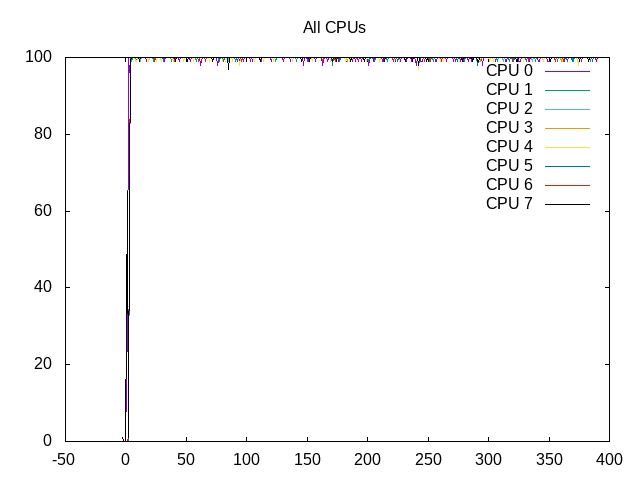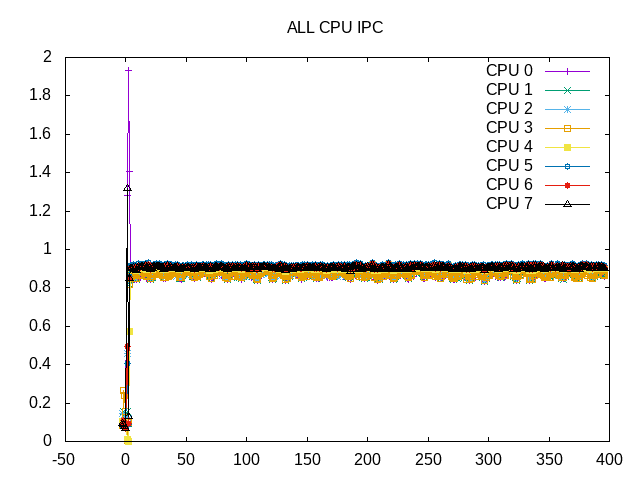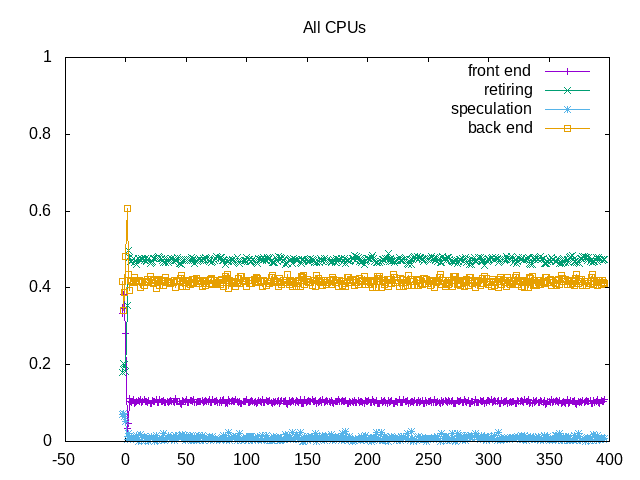The Partnership for Advanced Computing in Europe (PRACE) has a Unified European Applications Benchmark Suite including this example for gromacs.
This benchmark seems to be more regularly updated, which will allow me to use a more recent version of gromacs than one used in the lysozyme in water tutorial. This is helpful because the newer versions of Gromacs came after Ryzen was released and hence have better defaults for the platform. The only potential downside is if the working sizes are larger than for my single node systems.
The benchmark run instructions include a “-maxh 0.50” option which terminates the computation after 30 minutes. I have added this to my runs as well though the ion channel workload completes in 396 seconds. This does mean that AMD and Intel might differ in how much work gets done on the lignocellulose workload.
Some things are in common across both workloads
- On_CPU is close to 100%
- Frontend stall slots are somewhat more than 10% and appear to be more bandwidth (bad packing) than icache or itlb misses
- Backend stall slots are 30-40% and seem like memory misses. Interestingly analysis with fewer atoms (ion channel) seems to have fewer backend stalls than the larger simulation (lignocellulose)
- Speculative misses look like 10% in one metric but less than 2% in the per process metrics/graphs, perhaps something in the measurements (e.g. idle time or something else?)
ion channel workload
Metrics (Intel) - gromacs/prace/ion
run_ion.sh - pid 7481 On_CPU 0.994 On_Core 7.952 IPC 0.892 Retire 0.378 (37.8%) FrontEnd 0.103 (10.3%) Spec 0.102 (10.2%) Backend 0.417 (41.7%) Elapsed 394.96 Procs 9 Maxrss 276K Minflt 102522 Majflt 0 Inblock 0 Oublock 64 Msgsnd 0 Msgrcv 0 Nsignals 0 Nvcsw 3069 (13.0%) Nivcsw 20538 Utime 3139.521124 Stime 1.175834 Start 63379.56 Finish 63774.52
Runtime of six and a half minutes, some I/O but overall On_CPU is very close to 100%. The IPC of this workload is slightly lower and backend stalls are higher than other gromacs workloads. Speculative misses differ from shown in the graph or process metric.
Metrics (AMD) - gromacs/prace/ionrun_ion.sh - pid 1988 On_CPU 0.985 On_Core 15.768 IPC 1.123 FrontCyc 0.000 (0.0%) BackCyc 0.000 (0.0%) Elapsed 268.15 Procs 17 Maxrss 380K Minflt 163967 Majflt 99 Inblock 26800 Oublock 64 Msgsnd 0 Msgrcv 0 Nsignals 0 Nvcsw 20305 (4.6%) Nivcsw 418397 Utime 4226.525914 Stime 1.551173 Start 201.66 Finish 469.81
These metrics are a good contrast with the lysozyme tutorial in that the AMD IPC is now higher than the Intel IPC and both the elapsed time and reported ns/day are also proportionally higher.
Process Tree - gromacs/prace/ion
Process Tree
The process tree is simple.
7481) run_ion.sh 7484) gmx 7486) gmx 7487) gmx 7488) gmx 7489) gmx 7490) gmx 7491) gmx 7492) gmx
The logfile tells me
Using 1 MPI thread Using 8 OpenMP threads
while the AMD configuration is using 16 MPI threads and 1 OpenMP thread. However, performance on AMD is same or slightly higher for the multiple MPI threads than a single MPI thread. The AMD performance isn’t quite double Intel whereas this is the case in other benchmarks.
 About this graph
About this graph
Shows the Cores are scheduled almost 100% of the time.

IPC is very consistent across cores and across time.
 About this graph
About this graph
Topdown metrics also consistent across time. So probably fine to get performance samples using fewer steps.
on_cpu 0.994 elapsed 392.832 utime 3122.764 stime 1.081 nvcsw 2694 (11.06%) nivcsw 21667 (88.94%) inblock 0 onblock 64 retire 0.473 ms_uops 0.008 speculation 0.008 branch_misses 5.66% machine_clears 94.34% frontend 0.104 idq_uops_delivered_0 0.044 icache_stall 0.002 itlb_misses 0.000 idq_uops_delivered_1 0.048 idq_uops_delivered_2 0.054 idq_uops_delivered_3 0.062 dsb_ops 79.30% backend 0.416 resource_stalls.sb 0.094 stalls_ldm_pending 0.310 l2_refs 0.020 l2_misses 0.009 l2_miss_ratio 45.24% l3_refs 0.007 l3_misses 0.002 l3_miss_ratio 29.88%
While the frontend stalls are ~10%, a majority of these come from 1-3 uops rather than 0, this says more an issue of bandwidth than itlb/icache misses. The uop cache gets used for almost 80% of the uops. The backend stalls correlate with memory miss rates for the caches.
lignocellulose workload
Metrics (Intel) - gromacs/prace/lignocellulose
run_lignocellul - pid 7801 On_CPU 0.994 On_Core 7.952 IPC 1.114 Retire 0.459 (45.9%) FrontEnd 0.122 (12.2%) Spec 0.134 (13.4%) Backend 0.285 (28.5%) Elapsed 1823.98 Procs 9 Maxrss 3567K Minflt 3104334 Majflt 0 Inblock 0 Oublock 311008 Msgsnd 0 Msgrcv 0 Nsignals 0 Nvcsw 27453 (22.8%) Nivcsw 93173 Utime 14498.313559 Stime 5.504345 Start 66015.52 Finish 67839.50
The elapsed time is just over 30 minutes. This seems to be because of the time limit (30 minutes) rather than the number of steps (10,000) as the logfile says 2650 steps were completed. Similar to the ion channel run, the On_CPU is almost 100%. The IPC is higher and the backend stalls are lower.
Metrics (AMD) - gromacs/prace/lignocelluloserun_lignocellul - pid 2016 On_CPU 0.987 On_Core 15.788 IPC 1.220 FrontCyc 0.000 (0.0%) BackCyc 0.000 (0.0%) Elapsed 1818.66 Procs 17 Maxrss 5858K Minflt 5064327 Majflt 4 Inblock 384 Oublock 155552 Msgsnd 0 Msgrcv 0 Nsignals 0 Nvcsw 126434 (4.3%) Nivcsw 2783967 Utime 28697.746891 Stime 15.419367 Start 479.90 Finish 2298.56
Again the IPC on AMD is slightly higher than for Intel.
Process Tree - gromacs/prace/lignocelluloseProcess Tree
7801) run_lignocellul 7803) gmx 7804) gmx 7805) gmx 7806) gmx 7807) gmx 7808) gmx 7809) gmx 7810) gmx
The process tree is identical.
 About this graph
About this graph
Cores are scheduled almost 100%.

IPC is consistent across time and cores.
 About this graph
About this graph
Topdown metrics show some noise blur but are otherwise consistent.
on_cpu 0.994 elapsed 1824.866 utime 14500.964 stime 4.928 nvcsw 32993 (24.49%) nivcsw 101741 (75.51%) inblock 0 onblock 311008 retire 0.571 ms_uops 0.002 speculation 0.019 branch_misses 35.00% machine_clears 65.00% frontend 0.122 idq_uops_delivered_0 0.054 icache_stall 0.001 itlb_misses 0.000 idq_uops_delivered_1 0.058 idq_uops_delivered_2 0.062 idq_uops_delivered_3 0.070 dsb_ops 92.13% backend 0.288 resource_stalls.sb 0.023 stalls_ldm_pending 0.229 l2_refs 0.032 l2_misses 0.006 l2_miss_ratio 17.84% l3_refs 0.004 l3_misses 0.002 l3_miss_ratio 37.94%
Compared with the ion_channel workload, an even higher usage of the uop cache. Backend stalls and memory misses slightly lower and IPC is higher.
